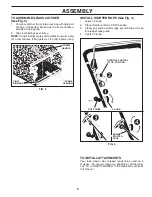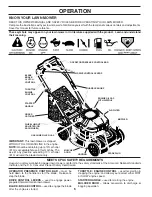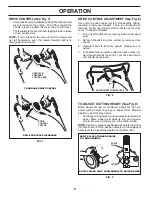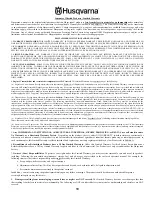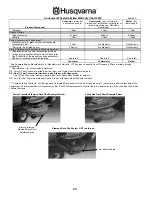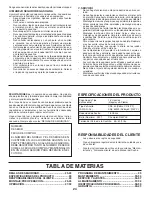
11
•
For extremely heavy cutting, reduce the width of cut
by overlapping previously cut path and mow slowly.
•
For better grass bagging and most cutting conditions,
the engine speed should be set in the fast position.
•
Pores in cloth grass catchers can become fi lled with dirt
and dust with use and catchers will collect less grass.
To prevent this, regularly hose catcher off with water
and let dry before using.
•
Keep top of engine around starter clear and clean of
grass clippings and chaff. This will help engine air fl ow
and extend engine life.
MULCHING MOWING TIPS
IMPORTANT
: FOR BEST PERFORMANCE, KEEP MOWER
HOUSING FREE OF BUILT-UP GRASS AND TRASH. SEE
“CLEANING” IN THE MAINTENANCE SECTION OF THIS
MANUAL.
• The special mulching blade will recut the grass clip-
pings many times and reduce them in size so that as
they fall onto the lawn they will disperse into the grass
and not be noticed. Also, the mulched grass will biode-
grade quickly to provide nutrients for the lawn. Always
mulch with your highest engine (blade) speed as this
will provide the best recutting action of the blades.
•
Avoid cutting your lawn when it is wet. Wet grass tends
to form clumps and interferes with the mulching action.
The best time to mow your lawn is the early afternoon.
At this time the grass has dried, yet the newly cut area
will not be exposed to direct sunlight.
• For best results, adjust the lawn mower cutting height
so that the lawn mower cuts off only the top one-third
of the grass blades (See Fig. 15). If the lawn is over-
grown it will be necessary to raise the height of cut to
reduce pushing effort and to keep from overloading
the engine and leaving clumps of mulched grass. For
extremely heavy mulching, reduce your width of cut by
overlapping previously cut path and mow slowly.
OPERATION
•
Certain types of grass and grass conditions may require
that an area be mulched a second time to completely
hide the clippings. When doing a second cut, mow
across (perpendicular) to the fi rst cut path.
•
Change your cutting pattern from week to week. Mow
north to south one week then east to west the next
week. This will help prevent matting and graining of
the lawn.
FIG. 15
MAX 1/3
TO STOP ENGINE (See Fig. 14)
•
To stop engine, place throttle/engine control in STOP
position.
TO START ENGINE (See Fig. 14)
NOTE:
Due to protective coatings on the engine, a small
amount of smoke may be present during the initial use of
the product and should be considered normal.
NOTE:
Your engine is equipped with an automatic choke
system. No priming or choking is required before start-
ing.
•
To start a cold engine, place throttle/engine control in
START position. This step is not usually necessary
when starting an engine which has already run for a
few minutes.
•
To start a warm engine, place throttle/engine control in
FAST position and pull starter handle quickly. Do not
allow starter rope to snap back.
MOWING TIPS
CAUTION: Do not use de-thatcher
blade attachments on your mower.
Such attachments are hazardous, will
damage your mower and could void
your warranty.
•
Under certain conditions, such as very tall grass, it
may be necessary to raise the height of cut to reduce
pushing effort and to keep from overloading the engine
and leaving clumps of grass clippings. It may also be
necessary to reduce ground speed and/or run the lawn
mower over the area a second time.
FIG. 14
START
FAST
SLOW
STOP
Summary of Contents for 961430094
Page 44: ...12 03 2013 BY ...





